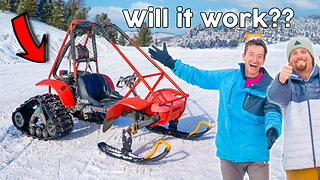Premium Only Content

LORDOSIS VS KYPHOSIS: DIFFERENCES EXPLAINED. CAUSES OF LORDOSIS AND KYPHOSIS
#Lordosis #kyphosis #nursing
LORDOSIS VS KYPHOSIS: DIFFERENCES EXPLAINED. CAUSES OF LORDOSIS AND KYPHOSIS
After watching this video you will never forger the difference between lordosis and kyphosis. I give you funny examples to help you remember.
KYPHOSIS
Abnormal vertebrae can be caused by:
• Fractures. Broken or crushed vertebrae (compression fractures) can result in curvature of the spine. Mild compression fractures often don't produce noticeable signs or symptoms.
• Osteoporosis. OVER TIME, WEDGING, AND FRACTURES OF THE VERTEBRAE PRODUCE GRADUAL LOSS OF HEIGHT AND A HUMPED BACK. This bone-thinning disorder can cause spinal curvature, especially if weakened vertebrae result in compression fractures. Osteoporosis is most common in older women and people who have taken corticosteroids for long periods of time.
• Disk degeneration. Soft, circular disks act as cushions between spinal vertebrae. With age, these disks dry out and shrink, which often worsens kyphosis.
• Scheuermann's disease. Also called Scheuermann's kyphosis, this disease typically begins during the growth spurt that occurs before puberty. Boys are affected more often than girls.
• Birth defects. Spinal bones that don't develop properly before birth can cause kyphosis.
• Syndromes. Kyphosis in children can also be associated with certain syndromes, such as Ehlers-Danlos syndrome and Marfan syndrome.
• Cancer and cancer treatments. Cancer in the spine can weaken vertebrae and make them more prone to compression fractures, as can chemotherapy and radiation cancer treatments.
Lordosis Causes
What causes spine curvature disorders?
There are a number of health problems that may cause the spine to curve more than normal or be misaligned.
The following conditions can cause lordosis:
• Achondroplasia: A disorder in which bones do not grow normally, resulting in the short stature associated with dwarfism
• Spondylolisthesis: A condition in which a vertebrae, usually in the lower back, slips forward
• Osteoporosis, a condition in which vertebrae become fragile and can be easily broken (compression fractures)
• Obesity, or being extremely overweight
• Kyphosis: A condition marked by an abnormally rounded upper back
• Discitis: Inflammation of the disc space between the bones of the spine most often caused by infection
• Benign (harmless) juvenile lordosis
As always thank you for watching your support means the world to me. If you want to help fund more videos consider donating to my Patreon account. I love making videos for my subscribers. If you would like to support the cause feel free to donate at:
patreon.com/nursingwithprofessorb
Follow me on IG: Nursing with Professor B
Join my FB group: https://mmini.me/NursingwithProfessorB
EMAIL: NURSINGWITHPROFESSORB@GMAIL.COM
Use of this InformationThe information included at this site is for educational purposes only and is not intended to be a substitute for medical treatment by a health care professional. Or specific/personal medical advice from me to you. Watching the videos or getting answers to comments/question, does not establish a nurse practitioner-patient relationship.
Because of unique individual needs, the reader should consult his or her personal physician to determine the appropriateness of the information for the reader's situation.
-
 2:55:11
2:55:11
TimcastIRL
4 hours agoDemocrat TANTRUM At Trump Speech BACKFIRES, Trump Polls UP, Dems UNDER FIRE w/67Kevin | Timcast IRL
142K68 -
 1:25:23
1:25:23
Kim Iversen
6 hours agoFrom Doctor to Political Prisoner: Dr. Simone Gold on COVID Lies, January 6th, and Medical Tyranny
53.2K39 -
 2:09:28
2:09:28
Melonie Mac
8 hours agoGo Boom Live Ep 39!
42.4K8 -
 1:04:36
1:04:36
Man in America
9 hours ago🚨 BREAKING: Dr. Robert Young JAILED! Medical Tyrants Will Do ANYTHING to Silence Truth
28.4K16 -
 LIVE
LIVE
I_Came_With_Fire_Podcast
7 hours agoPanama CANAL BlackROCKED | Left of PODCASTING | Ukraine AID GONE
546 watching -
 45:56
45:56
Glenn Greenwald
7 hours agoLee Fang Reacts to Trump's Speech to Congress; Will DOGE Tackle Military Waste? | SYSTEM UPDATE #418
82K83 -
 43:23
43:23
Donald Trump Jr.
7 hours agoNo Clap: Dems are a Disgrace but My Father is Bringing Back Common Sense | Triggered Ep.222
129K114 -
 18:29
18:29
The Rad Factory
1 day ago $0.83 earnedBuilding Shred Eighty a Custom Honda Snow Kart
21.3K6 -
 UPCOMING
UPCOMING
Precision Rifle Network
1 day agoS4E7 Guns & Grub - What makes group size increase?
14.3K2 -
 46:29
46:29
SGT Report
1 day agoAMERICA IS BACK! BYE BYE IRS!! -- Sam Anthony
55K83